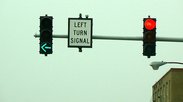
One of the funnest experiences you can have in a public restroom is when someone suddenly rattles the door to your stall, or door to the bathroom if you’re in a single shooter, hoping to find it unoccupied. Many doors appear closed when they are in fact slightly open, or are actually closed but are not locked/occupied. While this jarring experience could help you on your way, more than likely it will inspire feelings of agitation at being bothered in a precarious state, or guilt at taking too long in said state.
From the other perspective, one of the least fun experiences you can have in a public place is when you head to the restroom, only to find your rest thwarted by another. For example, at a nice restaurant, there is a certain emotion associated with the long walk to the restroom, the locked door or stall, the pause, and then the decision to either make the long walk back to the table (and ensuing repeat of the trip), or to casually “hang-out” near the restroom, which is hopefully near the kitchen door so that you get to acknowledge the staff while you wait. Since the invention of cell phone apps, this sort of waiting is far easier to endure, but it’s still less than optimal.
If you’ve ever experienced this “access denied” when searching for relief, you know what fun it is to anticipate whether the door is locked or not upon approach. Are there any telltale signs that the restroom is occupied? A light under the door? How badly do you need to go, and where is the next restroom going to be? These are all good questions.
One potential solution, and something that I think about more often than the average bear I’m sure, is the restroom indicator. This was made famous by airlines, and might even be used elsewhere. It’s a simple device that indicates whether a restroom is occupied or not by attaching a signal to the door lock. So when the door locks, the sign says stop. When it unlocks, Simon says go. Imagine if every stall door or single restroom had this technology? How much time would we save? Ok, maybe not time. But think of the satisfaction of always knowing when you can go, when you got to go.
TL;DR
You should carry around a sign with one of those plastic suction cup things with you that reads “In Use” for when using public restrooms.
From the other perspective, one of the least fun experiences you can have in a public place is when you head to the restroom, only to find your rest thwarted by another. For example, at a nice restaurant, there is a certain emotion associated with the long walk to the restroom, the locked door or stall, the pause, and then the decision to either make the long walk back to the table (and ensuing repeat of the trip), or to casually “hang-out” near the restroom, which is hopefully near the kitchen door so that you get to acknowledge the staff while you wait. Since the invention of cell phone apps, this sort of waiting is far easier to endure, but it’s still less than optimal.
If you’ve ever experienced this “access denied” when searching for relief, you know what fun it is to anticipate whether the door is locked or not upon approach. Are there any telltale signs that the restroom is occupied? A light under the door? How badly do you need to go, and where is the next restroom going to be? These are all good questions.
One potential solution, and something that I think about more often than the average bear I’m sure, is the restroom indicator. This was made famous by airlines, and might even be used elsewhere. It’s a simple device that indicates whether a restroom is occupied or not by attaching a signal to the door lock. So when the door locks, the sign says stop. When it unlocks, Simon says go. Imagine if every stall door or single restroom had this technology? How much time would we save? Ok, maybe not time. But think of the satisfaction of always knowing when you can go, when you got to go.
TL;DR
You should carry around a sign with one of those plastic suction cup things with you that reads “In Use” for when using public restrooms.

 RSS Feed
RSS Feed